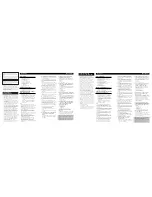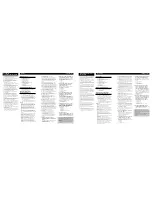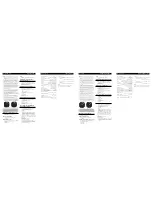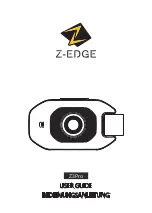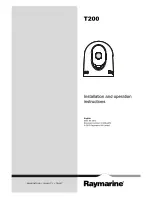
Especificaciones
<ESPAÑOL>
Conexión
<ESPAÑOL>
Power source .......................................... 14.4 V DC
(10.8 — 15.1 V allowable)
Grounding system .............................. Negative type
Max. current consumption .......................... 130 mA
Output video ........................................ Mirror image
(for rear view confirmation)
Sensor ............................ 1/4-inch color CCD sensor
No. of pixels ........ 491 (vertical)
×
512 (horizontal)
(Effective no. of pixels roughly 250,000)
Lens ........................................................Wide-angle,
focal length f = 1.94 mm, F value 2.8
Angle of view .................... Horizontal: approx. 112º
Vertical: approx. 82º
Iris system .......................................... Electronic iris
Scanning system ........................................ Interlace
Synchronizing system ........ Internal synchronization
Signal-to-noise ratio .......................... 40 dB or more
(at the recommended intensity of illumination)
Horizontal resolution ............ Approx. 300 TV lines
Illumination range .......... Approx. 1.5 — 100,000 lux
Image output ...................................... 1 Vp-p (75
Ω
)
Operation temperature range .......... –10ºC — +60ºC
+14ºF — +140ºF
Storage temperature range .............. –20ºC — +80ºC
–4ºF — +176ºF
Dimensions
Camera unit .... 50 (W)
×
25 (H)
×
20.5 (D) mm
2 (W)
×
1 (H)
×
3/4 (D) in.
Power supply unit
.......................... 70 (W)
×
35 (H)
×
25 (D) mm
2-3/4 (W)
×
1-3/8 (H)
×
1 (D) in.
Weight
Camera unit ................................ 120 g (0.3 lbs)
(including the cable)
Power supply .............................. 150 g (0.3 lbs)
(including the power cord)
Note:
Specifications and the design are subject to possible
modification without prior notice due to improve-
ments.
Specifications
<ENGLISH>
Connection
<ENGLISH>
Note:
• This unit is for vehicles with a 12-volt battery and nega-
tive grounding. Before installing it in a recreational vehi-
cle, truck, or bus, check the battery voltage.
• To avoid shorts in the electrical system, be sure to dis-
connect the
≠
battery cable before beginning installa-
tion.
• Refer to the owner’s manual for details on connecting the
other units, then make connections correctly.
• Secure the wiring with cable clamps or adhesive tape. To
protect the wiring, wrap adhesive tape around them
where they lie against metal parts.
• Route and secure all wiring so it cannot touch any mov-
ing parts, such as the gear shift, handbrake and seat rails.
Do not route wiring in places that get hot, such as near
the heater outlet. If the insulation of the wiring melts or
gets torn, there is a danger of the wiring short-circuiting
to the vehicle body.
• Do not shorten any leads.
• Never feed power to other equipment by cutting the insu-
lation of the power supply lead of the unit and tapping
into the lead. The current capacity of the lead will be
exceeded, causing over heating.
• When replacing fuse, be sure to use only fuse of the rat-
ing prescribed on the fuse holder.
• To minimize noise locate the TV antenna cable, radio
antenna cable and RCA cable as far away from each
other as possible.
• Connection to a TV with an RCA video input is possible,
but confirm whether the TV you use has a reverse gear
connection function.
• If this unit is installed in a vehicle that does not have an
ACC (accessory) position on the ignition switch, the red
lead of the unit should be connected to a terminal cou-
pled with ignition switch ON/OFF operations. If this is
not done, the vehicle battery may be drained when you
are away from the vehicle for several hours.
• Cords for this product and those for other products may
be different colors even if they have the same function.
When connecting this product to another product, refer to
the supplied manuals of both products and connect cords
that have the same function.
Connection sample (Fig. 12)
1
Power supply unit
2
Rear view camera
Video input jack
Connect to video input jack.
3
RCA cable
Accessory power supply
To electric terminal controlled by ignition
switch (12 V DC) ON/OFF.
4
Red
5
Fuse (1A)
Ground
To vehicle (metal) body.
6
Black
Installation with a lock tie (Fig. 13)
When connecting the rear view camera and
the power supply unit, secure the cord to
the power supply unit with the lock tie.
1
Lock tie
Cord installation (Fig. 14)
1
Clamps
2
Rear view camera
3
RCA cable
4
Product with a video input jack
(Hideaway unit etc.)
5
Power supply unit
6
Made with a rasp etc.
7
Scuff plate
8
Clamp
9
Waterproof plate
Cord installation points (Fig. 15)
• When pulling the cord out of the car,
pull from the outer side of the hatch har-
ness cover and hinge.
1
Pull out from here
2
Hinge
3
Harness cover
4
Rear view camera
5
Hatch
After cord installation (Fig. 16, Fig. 17)
• Open and close the hatch door slowly to
confirm that the cord is not rubbing
against the rim of the door.
1
Rear view camera
2
Hatch
3
Cord
• When the rear view camera cord cannot
be pulled out from the lower side due to
the type of car.
As shown in the figure 17, bend the cord
into a U shape in front of the waterproof
pad, making sure that rain water cannot
enter the car by running down the cord.
1
Clamps
2
Waterproof pad
3
Rubber packing
4
Make a U-shaped loop in the lead outside the
rubber packing to prevent rainwater from
flowing along the lead into the interior of the
vehicle.
No ACC position
ACC position
ON
S
T
A
R
T
O
FF
ACC
ON
S
T
A
R
T
O
FF
Fuente de alimentación ............................ CC 14,4 V
10,8 — 15,1 V permisible)
Sistema de conexión a tierra .............. Tipo negativo
Consumo de corriente máx. ........................ 130 mA
Vídeo de salida ............................ Imagen de espejo
(para confirmación de vista posterior)
Sensor .......... Sensor CCD de color de 1/4 pulgadas
No. de píxeles ...... 491 (vertical)
×
512 (horizontal)
(No. efectivo de píxeles aproximadamente 250.000)
Lente .................................................. Gran angular,
distancia focal f = 1,94 mm, valor F 2.8
Ángulo de visión .................. Horizontal: aprox. 112º
Vertical: aprox. 82º
Sistema de diafragma ............ Diafragma electrónico
Sistema de escaneo ................................ Entrelazado
Sistema de sincronización .... Sincronización interna
Relación señal/ruido ...................... 40 dB o superior
(en la intensidad recomendad de iluminación)
Resolución horizontal ...... Aprox. 300 líneas de TV
Rango de iluminación
...................................... Aprox. 1,5 — 100.000 lux
Salida de imagen ................................ 1 Vp-p (75
Ω
)
Rango de temperatura de funcionamiento
...................................................... –10ºC — +60ºC
Rango de temperatura de almacenamiento
...................................................... –20ºC — +80ºC
Dimensiones
Unidad de cámara
.................. 50 (An.)
×
25 (Al.)
×
20,5 (Pr.) mm
Unidad de suministro de energía
...................... 70 (An.)
×
35 (Al.)
×
25 (Pr.) mm
Peso
Unidad de cámara
................................ 120 g (incluyendo el cable)
Suministro de energía
................................ 150 g (incluyendo el cable)
Nota:
Las especificaciones y el diseño están sujetos a posi-
bles modificaciones sin previo aviso debido a mejo-
ramientos.
Nota:
• Esta unidad es para vehículos con una batería de 12 voltios y
masa negativa. Antes de montarlo en un autobús, camión o
vehículo de recreación, compruebe el voltaje de la batería.
• Para evitar cortocircuitos en el sistema eléctrico, cerciórese de
desconectar el cable de batería
≠
antes de comenzar la
instalación.
• Para los detalles sobre la conexión a otras unidades, refiérase
al manual del propietario y luego haga las conexiones
correctamente.
• Asegure el cableado con grapas de cable o cinta aisladora.
Para proteger el cableado, envuelva con cinta aisladora
alrededor del cableado en las partes en donde se apoya contra
las partes metálicas.
• Pase y asegure todo el cableado de modo que no toque
ninguna de la partes móviles, tales como engranaje de
cambio, freno de mano y carriles del asiento. No pase el
cableado por lugares que se calientan, tales como cerca una
salida del calefactor. Si la aislación del cableado se derrite o se
rompe, existe el peligro de que el cableado se ponga en
cortocircuito con la carrocería del vehículo.
• No ponga en cortocircuito ninguno de los conductores.
• No alimente otro equipo cortando la aislación del conductor
de suministro de alimentación de la unidad y enrrollando en el
conductor. La capacidad actual del conductor será excedida,
ocasionando sobrecalentamiento.
• Cuando reemplace el fusible, cerciórese de usar solamente el
fusible indicado en el portafusible.
• Para minimizar el ruido, ubique el cable de antena de TV,
cable de antena de radio y cable RCA lo más lejos posible
el uno del otro.
• Se puede hacer la conexión a un televisor con entrada de
vídeo RCA, pero compruebe si el televisor tiene una
función de conexión de marcha atrás.
• Si se instala esta unidad en un vehículo que no tiene una
posición ACC (accesorio) en el interruptor de encendido, el
conductor rojo de la unidad deberá conectarse al terminal
conectado con las operaciones del interruptor de encendido
ON/OFF. Si no se hace esto, la batería del vehículo podría
drenarse cuando usted esté lejos del vehículo por varias horas.
• Los cables para este producto y aquéllas para otros productos
pueden ser de colores diferentes aun si tienen la misma
función. Cuando se conecta este producto a otro, refiérase a
los manuales de ambos productos y conecte los cables que
tienen la misma función.
Muestra de conexión (Fig. 12)
1
Unidad de suministro de energía
2
Cámara de vista posterior
Toma de entrada de vídeo
Conecte a la toma de entrada de vídeo.
3
Cable RCA
Suministro de energía de accesorios
Al terminal de energía eléctrica controlado por el
interruptor de encendido del vehículo (12 V CC) ON/OFF.
4
Rojo
5
Fusible (1A)
Conexión a tierra
A la carrocería del vehículo (parte metálica).
6
Negro
Instalación con un enlace de fijación (Fig. 13)
Cuando conecte la cámara de vista posterior y
la unidad de suministro de energía, fije el
cable a la unidad de suministro de energía con
el enlace de fijación.
1
Enlace de fijación
Instalación del cable (Fig. 14)
1
Abrazaderas
2
Cámara de vista posterior
3
Cable RCA
4
Producto con una toma de entrada de vídeo
(Unidad oculta, etc.)
5
Unidad de suministro de energía
6
Hecho con una escofina, etc.
7
Placa de marca
8
Abrazadera
9
Placa impermeable
Puntos de instalación del cable (Fig. 15)
• Cuando tire del cable del coche, tire del
lado exterior de la cubierta de arnés de la
escotilla y de la bisagra.
1
Tire de aquí
2
Bisagra
3
Cubierta de arnés
4
Cámara de vista posterior
5
Escotilla
Tras la instalación del cable (Fig. 16, Fig. 17)
• Abra y cierre lentamente la puerta de
escotilla para comprobar que el cable no
está frotando contra borde de la puerta.
1
Cámara de vista posterior
2
Escotilla
3
Cable
• Cuando no se puede tirar de la cámara de
vista posterior desde el lado inferior debido
al tipo de coche.
Como se muestra en la figura 17, doble el
cable en una forma de “U” delante de la
almohadilla impermeable, asegurándose de
que el agua de la lluvia no pueda entrar en el
coche bajando corriendo por el cable.
1
Abrazaderas
2
Almohadilla impermeable
3
Empaquetadura de caucho
4
Haga lazo en forma de “U” en el cable fuera
de la empaquetadura de caucho para evitar
que el agua de la lluvia fluya a lo largo del
cable al interior del vehículo.
No en la posición ACC
Posición ACC
ON
S
T
A
R
T
O
FF
ACC
ON
S
T
A
R
T
O
FF


